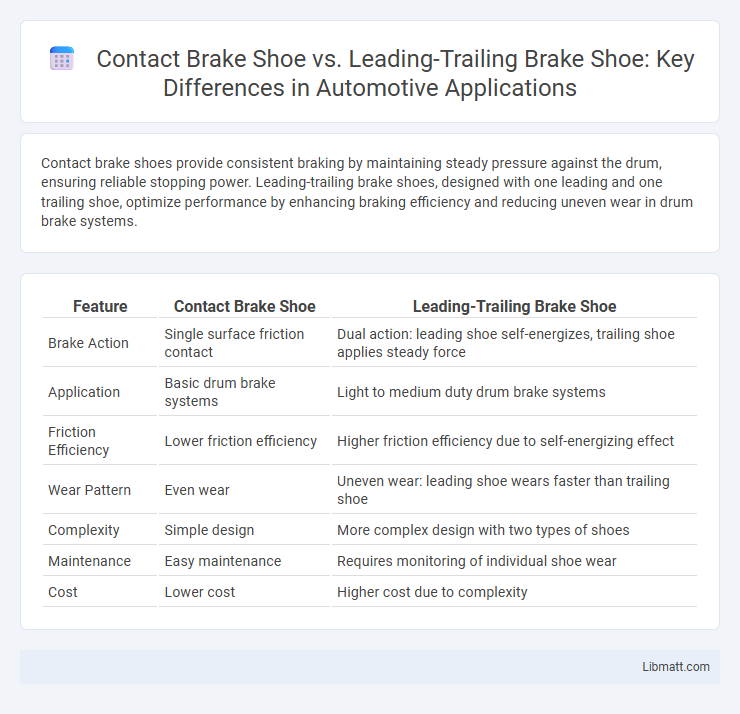Contact brake shoes provide consistent braking by maintaining steady pressure against the drum, ensuring reliable stopping power. Leading-trailing brake shoes, designed with one leading and one trailing shoe, optimize performance by enhancing braking efficiency and reducing uneven wear in drum brake systems.
Table of Comparison
| Feature | Contact Brake Shoe | Leading-Trailing Brake Shoe |
|---|---|---|
| Brake Action | Single surface friction contact | Dual action: leading shoe self-energizes, trailing shoe applies steady force |
| Application | Basic drum brake systems | Light to medium duty drum brake systems |
| Friction Efficiency | Lower friction efficiency | Higher friction efficiency due to self-energizing effect |
| Wear Pattern | Even wear | Uneven wear: leading shoe wears faster than trailing shoe |
| Complexity | Simple design | More complex design with two types of shoes |
| Maintenance | Easy maintenance | Requires monitoring of individual shoe wear |
| Cost | Lower cost | Higher cost due to complexity |
Introduction to Brake Shoe Types
Contact brake shoes press directly against the drum to create friction and slow the vehicle, offering reliable stopping power in standard drum brake systems. Leading-trailing brake shoes feature one leading shoe that provides strong initial braking force and one trailing shoe that supports sustained braking, optimizing performance and wear distribution. Your choice between these types impacts overall brake efficiency and maintenance frequency in various driving conditions.
What is a Contact Brake Shoe?
A contact brake shoe is a component in drum brake systems that directly presses against the brake drum to create friction and slow the vehicle. Unlike leading-trailing brake shoes, which have one shoe leading and the other trailing to provide balanced braking, contact brake shoes apply force uniformly without distinction between leading or trailing action. This design simplifies maintenance and is often used in light-duty or older drum braking applications.
What is a Leading-Trailing Brake Shoe?
A Leading-Trailing Brake Shoe system features one shoe positioned to lead the rotation of the drum, providing strong initial braking force, while the trailing shoe follows with a lighter braking effect, enhancing stability and wear distribution. This design improves braking performance on the front wheels of vehicles by balancing efficiency and durability. Your vehicle's braking system benefits from the leading shoe's self-energizing effect and the trailing shoe's consistent pressure, ensuring effective stopping power and longer component life.
Design Differences: Contact vs Leading-Trailing
Contact brake shoes utilize a uniform surface that presses evenly against the drum for consistent friction distribution, enhancing braking stability. Leading-trailing brake shoes feature an asymmetrical design with one shoe angled as the leading shoe to engage first and provide stronger initial stopping force, while the trailing shoe supports sustained braking. The contrasting layouts impact how each type manages heat dissipation, wear patterns, and overall brake system responsiveness.
Working Principle of Contact Brake Shoes
Contact brake shoes operate by pressing a friction material directly against the rotating drum, creating the necessary friction to slow down or stop the vehicle. Leading-trailing brake shoes consist of two types: the leading shoe, which is self-energizing due to the drum rotation pulling it into contact, and the trailing shoe, which pushes against the drum but without self-energizing effect. This configuration maximizes braking efficiency by using the self-energizing property on one shoe while maintaining balanced braking force with the other.
Working Principle of Leading-Trailing Brake Shoes
The working principle of leading-trailing brake shoes relies on the rotation direction of the drum, where the leading shoe is self-energizing by being pushed into the drum while the trailing shoe provides consistent braking force. Your vehicle's braking system benefits from this setup by combining stronger braking power with balanced wear. Contact brake shoes, in contrast, operate without a leading or trailing designation and rely solely on mechanical force applied through the brake linkage.
Performance Comparison: Stopping Power & Efficiency
Contact brake shoes provide consistent stopping power by maintaining direct contact with the drum, resulting in efficient heat dissipation and reliable braking performance. Leading-trailing brake shoes enhance stopping power through asymmetric force distribution, delivering stronger initial bite with the leading shoe and sustained braking by the trailing shoe, which improves overall efficiency and reduces wear. Your choice between these systems affects braking responsiveness and durability, with contact shoes favoring steady performance and leading-trailing designs optimizing stopping power in varying conditions.
Wear and Maintenance Considerations
Contact brake shoes typically experience more uniform wear due to consistent pressure distribution, resulting in predictable maintenance schedules and longer service intervals. Leading-trailing brake shoes show uneven wear patterns, with the leading shoe wearing faster than the trailing one, necessitating more frequent inspection and potential early replacement. Maintenance of leading-trailing brake systems requires careful monitoring of shoe alignment and wear rates to ensure balanced braking performance and prevent premature damage.
Common Applications in Vehicles
Contact brake shoes are commonly used in older drum brake systems found in passenger cars and light trucks due to their simple design and affordability. Leading-trailing brake shoes are typically found in heavier vehicles such as trucks and buses, where enhanced braking performance and longer shoe life are required. Your vehicle's braking system choice depends on load requirements and driving conditions, with leading-trailing designs offering better stability under heavy loads.
Choosing the Right Brake Shoe for Your Needs
Choosing the right brake shoe depends on your vehicle's performance requirements and operating conditions. Contact brake shoes offer consistent friction and are ideal for heavy-duty applications with high braking force needs. Leading-trailing brake shoes provide smoother braking and better wear distribution, making them suitable for lighter vehicles and those requiring balanced braking response.
Contact Brake Shoe vs Leading-Trailing Brake Shoe Infographic

 libmatt.com
libmatt.com